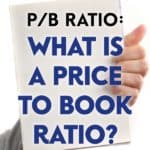P/B Ratio: What Is a Price to Book Ratio?

Price To Book Ratio, often simply referred to as P/B Ratio, can be used to make a comparison between the current market price of a stock and the total book value of all the assets that company has on the balance sheet. The P/B ratio is one of the measures you can use when evaluating the fundamentals a stock.
While P/E Ratio can help you find value stocks based on earnings, Price To Book Ratio allows you to look for value stocks by finding companies that are not heavily overvalued compared to what their assets are worth.
Understanding the P/B ratio can give you an idea of where a company should be at, considering its assets, as well as provide you with insight into whether the company is likely to recover if its price is currently slumping a little bit.
How is P/B Ratio Calculated?
Price To Book Ratio can be calculated as the total price of all outstanding shares (market capitalization) divided by the total book value of that company’s assets. You can also calculate P/B Ratio as the price per share divided by the book value per share. Either way will give you the same ratio, just a matter of what information you’re looking at: the entire total or the per share value.
Another thing to keep in mind with calculations like this is that what would be considered a low Price To Book Ratio for one sector might not be for another. So compare stocks within the same type of industry when value investing.
What Does the Price to Book Ratio Mean?
So what does a P/B Ratio of 1.0 really mean? It is a way of saying that things are basically in balance. It makes a good point of reference, even though the book value of assets might actually be different than the market value.
One way to look at “book value” is to consider it as the original price of an asset, after it has been reduced by amortization or depreciation. When your ratio is less than 1.0, it means the stock could be undervalued, and might make a good bargain. An investment that has a P/B above 1.0, it means that the stock is probably overvalued… and may not be a good deal.
A ratio of 0.75 means that you can actually buy shares in the company for less that the value of all its assets. At first glance, it appears to be a decent value. However, P/B ratio isn’t everything.
Keep in mind that, with any value calculation, sometimes stocks are low for good reason. A low Price To Book Ratio can mean that the company is in trouble and you should look further into whether the stock truly is a “value”.
While there P/B ratio isn’t perfect, it can provide you with a point of reference that you can use when comparing different investment options.


Comments
Great explanation! You’re quite right, however, that sometimes if the P/B ratio is low, it’s a sign the company is in trouble, not so much that it’s a great bargain.
“So what does a P/B Ratio of 1.0 mean? That would mean you can buy that stock for exactly what it’s assets would be worth if it were to go bankrupt today.”
I slightly disagree on this one since the book value of assets is usually different from the market value of these same assets.
Inventory would be sold for less than its book value. Real estate may be sold for more than its book value. Goodwill may be a complete loss…
Thanks for pointing that out JFR, I edited the post to clarify that better.
JFR is right.
“Book value” is simply the original price of the asset reduced by depreciation or amortization.
Depreciation and amortization refer to recognizing that assets have a finite life. Eventually, a machine is going to wear out, break down or simply become obsolete and need replacing, at which time the company must spend some more money.
Of course, nobody really knows the future, so the asset is reduced in value (on the books) by a set amount, based on industry, accounting standards and IRS rules.
So a widget-making machine that cost $1,000 in 2005 and is being depreciated over ten years, would now have a book value of $400. Its value has declined $100 per year for the past six years.
The actual market value of that machine may be effectively zero, or the worth of the scrap metal. But a new replacement may now cost %1,200.
However imprecise, “book value” is generally lower than the value of the business has an active, profit-generating enterprise. That is, that widget making machine should be valuable as part of an organization of widget sales people, other machines, the CEO, the janitor, and so on.
Therefore, if a company’s price to book ratio is low, that is a strong indicator that the price is close to bottom. Or it’s an indication that the business is not producing very much revenue in proportion to the assets it’s bought.
Companies in this situation may attract corporate raiders a la Gordon Gecko, who plan to get a better Return On Investment from the assets or, at worst, sell them off at a profit.
Or the company may get through its hard times in the future and become much more successful.
Or it may continue to go downhill and out of business.
Nobody knows the future.
Great analysis of the P/B Tom. Awesome job simplifying it and starting from the basics!
Good explanation! This is one of the reasons, I prefer to use mutual funds. There can be a variety of facts that can effect stock prices.
I agree with JFR that it is usually different from market value. Even from an accounting perspective a factory or plant depreciates over a long period of time but you would never think of selling it at book value over it’s market value.
I tend use P/B when looking at fixed income products and mutual funds not so much with stocks.
Its True, Price to Book Value is a key estimator before estimating the value of the company
Where, many people only take Price to Earnings (generally future earnings), Price to Book Value represents the assets. A high P/BV signifies that the company is already running on premium as against the assets value and thus may not be a good indicator
On a standalone basis, no ratio can give a true indication but when these key ratios like – P/B, P/E, Current Ratio, Liquidity Ratio clubs together – they actually can scan the entire financials of the company.